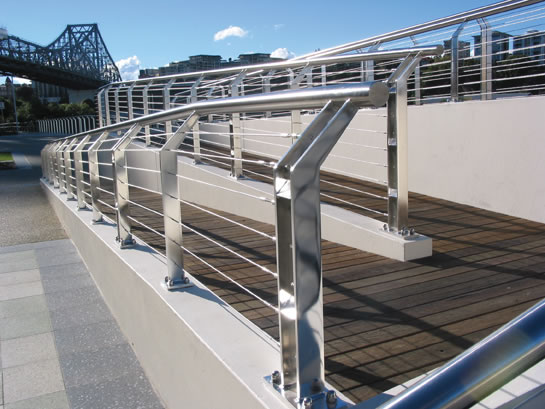ARCHITECTURAL ARTICLES
Extracts from the National Building Regulations
SABS 0400-1990 - The application of the National Building Regulations
The document covers provisions for building site operations and building design and construction that are deemed to satisfy the provisions of the National Building Regulations. In certain cases, commentary and illustrations to amplify and explain the application of the deemed-to-satisfy rules are included. Information on standardization of the application of the regulations is contained in a commentary to Part A of the regulations.
Prevention from falling.
- Any flight of steps which contain more than three rises shall have protection on each side provided by a secure wall, screen, railing or balustrade which shall be not less than 1 metre high and so erected that any such wall, screen, hand railing or balustrade in any occupancy classified E2, E3, H1, H2 or H3 shall not have any opening that permits the passage of a 100mm diameter ball. Provided that such protection in any occupancy not being an occupancy classified E2, E3, H1, H2, H3 or H4 shall consist of at least a handrail with another rail midway between such hand rail and the stair tread.
- Any flight of steps which contains more than five rises shall be provided with at least one continuous handrail extending the length of such flight; provided that this requirement shall not apply to any building classified H4 or within the individual dwelling units in occupancy classified H3. Such handrail shall be securely fixed to such wall, screen, railing or balustrade of a height not less than 850 mm and not more than 1 m measured vertically from the pitch line to the upper surface of the hand rail. Such handrail shall be of such a design and be so fixed that there shall be no obstruction on, above, or near to it which may obstruct the movement of any hand moving along it.
- Subject to this, any flight which is less than 1.1 metre wide shall have a handrail on at least one side and where the width of any flight is more than 1.1 metre handrail shall be provided on both sides of such flight.
Stainless Steel Cleaning Techniques*:
With a soft cloth or a damp, soapy sponge or isopropyl alcohol. In mirror finish, use clean glass. To reduce new occurrences, apply household polishes based on wax on the clean and dry surface.
Wash with water under pressure or steam. Use detergent.
Immerse the piece in warm water and rub with a soft cloth. If the adhesive persists, dry and use alcohol or an organic solvent. Never scrape with spatulas, blades or abrasives.
Thick deposits should be cleaned with a soft cloth. Then, the piece must be immersed in a solution of alkaline detergent or ammonia.
Treat the surface with 10% nitric acid solution and 2% hydrofluoric acid. Wash with plenty of water and dry.
With a fine abrasive, polish the surface. Decap the surface with a solution of 10% nitric acid and 2% sulfuric acid until all traces are eliminated. Electro polish or wash with warm water.
You can contact us for a quote. We have polishing facilities to assist.
The surface should be washed with a 20% nitric acid solution and then rinsed with water.
Polishing with a fine-grained abrasive.
You can contact us for a quote. We have polishing facilities to assist.
Polish with a fine-grained abrasive or, weld over if it is in the weld line.
You can contact us for a quote. We have polishing facilities to assist.
Can be prevented by the use of adhesive films on the sides of the weld bead, or removed with a fine-grained abrasive.
You can contact us for a quote. We have polishing facilities to assist.
Remove with grinders and re-weld.
You can contact us for a quote. We have grinding and polishing facilities to assist.
Can be washed with clean water or alkaline cleaners.
Dissolve with nitric or phosphoric acid. Rinse with clean water. If necessary, use a fine-grained abrasive.
You can contact us for a quote. We have polishing facilities to assist.
Use mild cleansing solution. Make sure that the solution you use is compatible with stainless steel. Phosphoric acid cleaners can also work. Use a cloth, sponge or fiber brush (nylon or natural bristle, it could be an old toothbrush). Rinse well with clean water and dry following the polishing lines.
Dissolve 1 part of vinegar in 3 parts of water. Soak in this solution and then brush to loosen the tank. Rinse well with clean water.
Use organic solvents (acetone, alcohol, methylated alcohol or certified products for stainless steel). The stuck grease can be loosened before applying the solvent, applying ammonia. Subsequently, clean with soap and water; Rinse with clean water and dry following the polishing lines.
*please use discretion by considering any water restrictions in your area

How to maintain stainless steel
Due to its excellent resistance and beauty, stainless steel is an easy-care material, sometimes tending to have the mistaken idea that it does not require maintenance. In order to preserve their innate qualities, it is necessary to follow some minimum recommendations during storage, handling and use, which with proper routine cleaning, allow to maintain the original characteristics unaltered, preserving their resistance to corrosion, hygiene and appearance of your balustrading and handrailing systems.
Stainless steel is the only metal that can regenerate itself. It has a thin layer of adherent oxides formed mainly by chromium, iron and nickel oxides which, when clean and properly formed, are quite inert, under most conditions. In this state it is said that stainless steel is “passive”. The following passivation treatments are mainly cleaning and do not induce passivity, but repair the defects on the surface and eliminate substances that may damage the surface film.
Remember that the secret of cleaning and maintenance is the use of proper procedures and products.




